Daphnes and prostrate Phlomis
I’ve had several goes at growing the deciduous Daphne genkwa. All met with failure. I had mistakenly imagined that as this species is native to China and 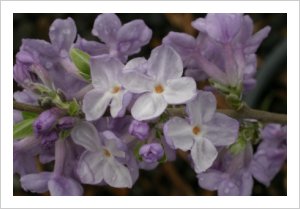 Korea it would need to be given rich soil in a lightly shaded spot. Nothing could be further from the truth. In its native habitat it grows on rocky limestone hillsides where it gets a good baking during summer. It was when I planted it in well drained soil in a hot sunny raised bed that I was finally successful. Before planting I dug over the bed and mixed in some compost and added a handful of lime per square metre. Once the Daphne was in it was mulched with finely screened blue metal to a depth of 2 to 3cm.
Korea it would need to be given rich soil in a lightly shaded spot. Nothing could be further from the truth. In its native habitat it grows on rocky limestone hillsides where it gets a good baking during summer. It was when I planted it in well drained soil in a hot sunny raised bed that I was finally successful. Before planting I dug over the bed and mixed in some compost and added a handful of lime per square metre. Once the Daphne was in it was mulched with finely screened blue metal to a depth of 2 to 3cm.
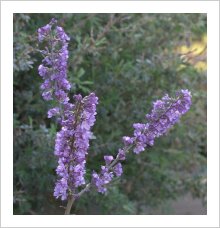 Large lilac-mauve flowers are held in clusters in the leaf axils of previous year’s wood and the effect is striking to see the branches, which can be up to 50cm or more long, covered in flowers.
Large lilac-mauve flowers are held in clusters in the leaf axils of previous year’s wood and the effect is striking to see the branches, which can be up to 50cm or more long, covered in flowers.
The area in the garden where I have Daphne genkwa growing is also home to two clones of Daphne cneorum.
In his marvellous book on the genus, Daphnes – A Practical Guide for Gardeners, Robin White writes that “This species is distributed over a large area of Europe, from France, northern Spain and Italy north to Slovakia, Poland and Hungary.”
As is to be expected in a plant with such a wide distribution and one which has also been cultivated for 250 years there are a large number of varieties available to European gardeners. Sadly we in Australia are less lucky as Daphnes are difficult to get through quarantine and very few nurseries grow or stock more than one or two species.
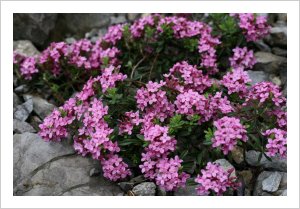 The Daphne cneorum in my garden is a vigorous dwarf shrub which grows 20cm tall and 50cm across. It has thin twiggy stems well clothed with small narrow dark green leaves and topped, in spring, by crowded heads of deep pink, fragrant flowers.
The Daphne cneorum in my garden is a vigorous dwarf shrub which grows 20cm tall and 50cm across. It has thin twiggy stems well clothed with small narrow dark green leaves and topped, in spring, by crowded heads of deep pink, fragrant flowers.
Daphne cneorum ‘Leila Haines’ was discovered quite recently growing in the mountains of northern Italy. It is much smaller in all its parts with narrower, glossier leaves, very deep pink almost red buds which open to bright pink fragrant flowers. It has made a tiny, tight, tidy shrub 10cm tall by as much across in a couple of years.
Daphne cneorum isn’t easy to propagate although thirty years ago I used to grow many hundreds every year. Now at best I get perhaps one in three cuttings to strike and these struck cuttings are slow to make decent plants in pots although once in the garden they soon take off.
I have made a series of raised beds in an open sunny and windy position. This is where I grow dry climate alpine plants from Greece, Turkey and adjacent countries.
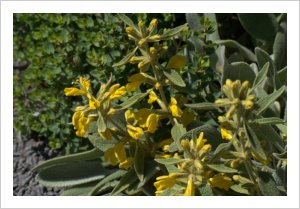 I’ve grown several plants of Phlomis sieheana from seed collected near Salda Lake in south western Turkey. In three years it has made evergreen mats of silver grey leaves some 60cm across. Soft and silky to touch these leaves are like refined lamb’s ears, but the Phlomis doesn’t have the scruffy down times which Stachys byzantina has. Phlomis sieheana has handsome yellow flowers in whorls on 30cm tall stems. The flowers, which remind me of eagle’s talons, are produced in October.
I’ve grown several plants of Phlomis sieheana from seed collected near Salda Lake in south western Turkey. In three years it has made evergreen mats of silver grey leaves some 60cm across. Soft and silky to touch these leaves are like refined lamb’s ears, but the Phlomis doesn’t have the scruffy down times which Stachys byzantina has. Phlomis sieheana has handsome yellow flowers in whorls on 30cm tall stems. The flowers, which remind me of eagle’s talons, are produced in October.
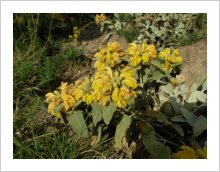 Phlomis capitata from Bolkar Dag in Turkey is similar in flower and growth habit but its leaves are not as handsome as P. sieheana, although the rich deep, lemon yellow flowers are very large for such a small plant.
Phlomis capitata from Bolkar Dag in Turkey is similar in flower and growth habit but its leaves are not as handsome as P. sieheana, although the rich deep, lemon yellow flowers are very large for such a small plant.
When I was younger I used to spend much of my spare time walking in the Victorian and New South Wales mountains. The alpine landscape filled me with awe as it does everyone. It’s hard to describe the wonder of it without sounding hackneyed. The sheer grandeur cured me of any fantasy I may have had of making a “natural” rock garden. From the Victorian grottoes, which used to bemuse me when I was child, to the Royal Horticultural Society’s Wisley effort, which looks more like the ruin of a badly built, fallen down Roman theatre than a mountain side, all the attempts at copying an alpine scene have been failures. It is an impossible task.
The Edinburgh Botanic Gardens have an alpine house which sits on a stage of stone paving behind a well built dry stone retaining wall. Stone troughs sit on the paving and little carpeting plants surround the troughs. When I visited the gardens thirty years ago the wall was planted with many superb alpines such as Verbascum dumulosum, the white flowered form of Daphne cneorum and Androsace strigillosa. There was no attempt to mimic nature here. It was really beautiful.